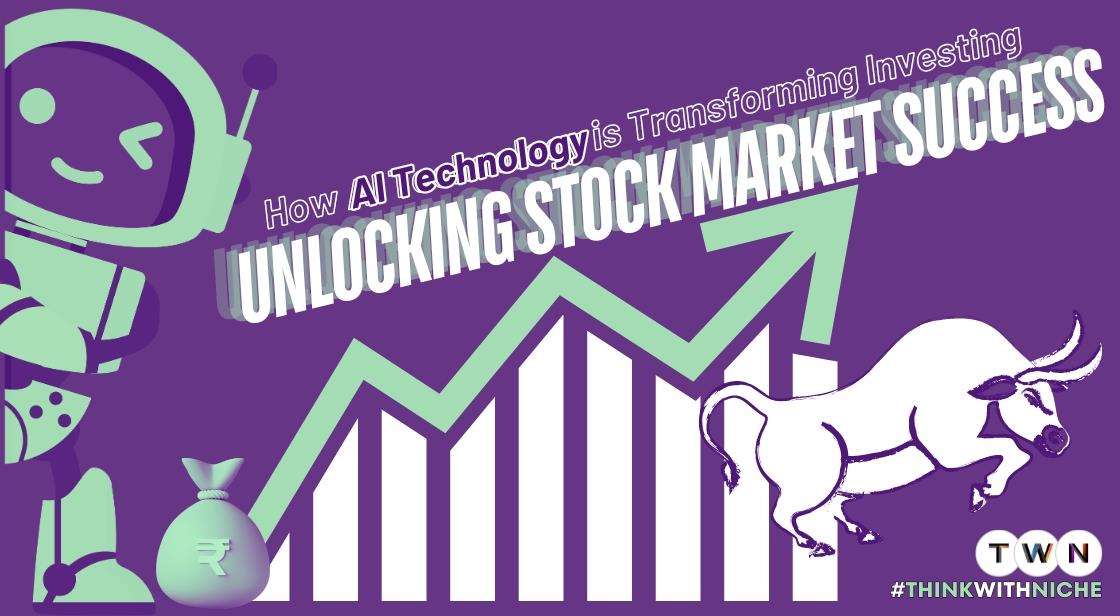How AI Technology is Transforming Investing: Unlocking Stock Market Success

Blog Post
The world of finance is witnessing a revolution driven by artificial intelligence (AI). AI algorithms are rapidly transforming how investors navigate the complexities of the stock market.
By analyzing vast amounts of data that goes beyond just price charts and company financials, AI can uncover hidden patterns, predict market movements, and even execute trades at lightning speed.
This data can include news sentiment analysis, social media trends, and even alternative data sources like satellite imagery tracking factory activity.
This newfound ability to process and interpret complex information allows AI to outperform traditional human analysis. Machine learning, a core component of AI, continuously refines these algorithms as they are exposed to more data, making them more efficient and effective at identifying profitable opportunities.
As a result, AI trading strategies are no longer the exclusive domain of hedge funds. Robo-advisors, algorithmic trading platforms, and AI-powered stock screeners are democratizing access to these powerful tools, empowering investors of all levels to make data-driven investment decisions.
However, while AI offers undeniable benefits, it's crucial to maintain a balanced approach. Investors should be aware of potential risks like the "black box problem" of opaque AI models and the dangers of over-reliance on technology.
By understanding both the power and limitations of AI, investors can leverage this exciting technology to achieve greater financial success in the ever-evolving stock market.
Unveiling the Secrets of AI Trading Technology:Smart Investing with AI
AI encompasses a range of technologies, including machine learning and deep learning, that enable computers to learn from data and make predictions. In the context of investing, AI algorithms can analyze vast amounts of historical market data, company financials, news sentiment, and social media trends to identify patterns and potential investment opportunities.
This ability to process and interpret complex data far surpasses human capabilities, allowing AI to uncover hidden correlations and predict future market movements with greater accuracy.
What is AI trading?
AI trading, also known as algorithmic trading, is rapidly reshaping the investment landscape. It leverages the power of artificial intelligence (AI), specifically machine learning and deep learning algorithms, to analyze vast amounts of data and make informed investment decisions. This goes far beyond simply crunching numbers – AI can identify complex patterns, predict future market movements, and even execute trades at lightning speed.
Demystifying AI Stock Trading: Algorithms, Machine Learning, and Market Insights
AI stock trading is rapidly transforming the financial landscape. It utilizes a range of sophisticated tools from the AI arsenal – machine learning, sentiment analysis, and algorithmic predictions – to navigate the complexities of the market. Let's delve deeper into how AI works its magic:
Unveiling the Data Whisperer: How AI Devours Information to Predict Markets
AI algorithms in the realm of stock trading act as sophisticated data whisperers, constantly ingesting and interpreting vast amounts of information from diverse sources. This allows them to identify subtle patterns, predict future trends, and ultimately, make informed investment decisions. Here's a deeper dive into the data sources that fuel AI's market intelligence:
1. Historical Market Trends: A Journey Through Time
AI meticulously analyzes historical data on price movements, trading volumes, and market cycles. This goes beyond just basic price charts. AI can delve into:
-
Intraday Data: High-frequency trading data allows AI to analyze short-term price fluctuations, identifying potential breakout opportunities or oversold conditions.
-
Volatility Patterns: By analyzing historical volatility data, AI can predict potential periods of market turbulence and suggest risk management strategies.
-
Seasonal Trends: AI can identify seasonal patterns in specific industries or asset classes, allowing investors to capitalize on recurring market movements.
Example: An AI algorithm might analyze historical data on tech stocks and discover a recurring pattern of price increases leading up to major technology conferences. This could inform an investment strategy to buy stocks in these companies before the conferences.
2. Company Financials: Unveiling the Financial DNA
AI doesn't just crunch numbers; it dissects company-specific data to gain a comprehensive understanding of a company's financial health and future prospects. This includes:
-
Financial Statements: AI can analyze income statements, balance sheets, and cash flow statements to assess a company's profitability, liquidity, and solvency.
-
Earnings Reports: AI can extract key metrics from earnings reports, such as earnings per share (EPS), revenue growth, and profit margins, to identify companies with strong fundamentals and growth potential.
-
Alternative Data Sources: Beyond traditional financial data, AI can also analyze alternative data sources like satellite imagery tracking factory activity or job posting trends to gauge a company's operational health and future outlook.
Example: AI might analyze a company's financial statements and earnings reports, identifying a consistent increase in revenue and profit margins. This could signal strong growth potential, prompting the AI to recommend investment in this company.
3. News and Social Media Sentiment: Decoding the Public Mood
AI goes beyond the realm of numbers, venturing into the world of public perception. It analyzes news articles, social media posts, and other forms of unstructured data to understand:
-
News Sentiment: AI can analyze news articles to gauge public sentiment towards specific companies or industries. Positive news coverage might indicate increased investor confidence, leading to potential price hikes.
-
Social Media Buzz: AI can analyze social media trends to identify companies gaining traction and potential shifts in consumer preferences. A surge in positive social media mentions for a particular company could signal rising interest from investors.
-
Brand Perception Analysis: AI can analyze online reviews and social media conversations to understand public perception of a company's brand and products. This can provide valuable insights into a company's long-term prospects.
Example: AI might analyze social media and news articles surrounding an electric vehicle company. If there's a surge in positive sentiment due to a new product launch, the AI could recommend investing in this company based on increased market interest.
4. Technical Analysis Indicators: Speaking the Language of Charts
AI doesn't neglect the language of technical analysis. It can analyze complex technical indicators like:
-
Moving Averages: AI can identify trends and potential turning points in the market by analyzing different moving average indicators.
-
Relative Strength Index (RSI): AI can use RSI to identify overbought or oversold conditions in a stock, suggesting potential entry or exit points for trades.
-
Momentum Indicators: AI can analyze momentum indicators to identify stocks with strong upward or downward trends, allowing investors to capitalize on market momentum.
Example: AI might analyze moving averages and RSI for a particular stock. If the RSI indicates the stock is oversold, and the moving averages suggest a potential upward trend, the AI could recommend buying the stock.
Also Read: What are the Top 10 AI Trends that will Reshape 2024 and Beyond?
The Power of Synthesis: A Symphony of Data
By analyzing this vast array of data sources, AI algorithms act as data whisperers, piecing together the complex puzzle of the financial markets. This allows AI to identify subtle patterns, predict future trends, and ultimately, generate valuable insights for informed investment decisions. However, it's important to remember that AI is a tool, and successful investment requires a combination of AI's data-driven insights with human expertise and sound investment judgment.
The Power of Machine Learning:
Machine learning is the engine that drives AI's analytical prowess. These algorithms continuously learn and improve as they are exposed to more data, enabling them to:
-
Identify Hidden Patterns: AI can uncover subtle relationships within vast datasets that human investors might miss. These hidden patterns can provide valuable insights for identifying profitable investment opportunities.
-
Predict Market Movements: By analyzing historical data and the newly identified patterns, AI can make informed predictions about future market trends. This predictive power allows investors to capitalize on potential market movements before they occur.
-
Refine Investment Strategies: As AI models are exposed to more data, they can adapt their strategies over time. This continuous learning process makes AI models more efficient and effective at navigating the ever-evolving market landscape.
A Spectrum of Trading Strategies: AI in Action
AI trading isn't a monolithic concept. It encompasses a range of strategies, catering to different investor needs:
-
Quantitative Trading (Quant Trading): This approach utilizes quantitative models to analyze price and volume data to identify optimal investment opportunities.
-
Algorithmic Trading (Algo-Trading): Here, investors pre-program a set of rules based on historical data. These algorithms automatically execute trades when specific market conditions are met. High-frequency trading (HFT) is a sub-category of algo-trading known for its rapid execution of large volumes of trades.
-
Automated Trading: This combines elements of quantitative analysis and historical data-driven algorithms to create a fully automated trading system. AI continuously monitors the market and executes trades based on pre-defined parameters.
Benefits of AI Trading: A Boon for Investors
AI trading offers a multitude of advantages for various market participants:
-
Enhanced Decision-Making: AI's ability to analyze vast amounts of data and identify complex patterns empowers investors to make more informed investment decisions.
-
Reduced Emotional Bias: Unlike human investors prone to emotions like fear and greed, AI operates objectively. This eliminates emotional biases that can lead to poor investment choices.
-
24/7 Market Monitoring: AI algorithms work tirelessly, constantly monitoring the market and identifying opportunities around the clock. Investors never miss a potential trading opportunity, even outside of regular trading hours.
-
Improved Risk Management: AI can be used to develop sophisticated risk management strategies. By analyzing historical trends and market volatility, AI can help investors identify and mitigate potential risks.
AI Stock Trading: Unveiling the Power of Machine Intelligence
What is AI STOCK TRADING?
AI stock trading, also known as algorithmic trading, is revolutionizing the investment landscape. It harnesses the power of artificial intelligence (AI) to make informed investment decisions and execute trades at lightning speed.
This goes beyond just analyzing data – AI delves into complex financial information, predicts market movements, and identifies optimal trading opportunities. Here's a breakdown of how AI is transforming the way we invest:
Unlocking the Power of Data:
AI algorithms are data guzzlers, capable of ingesting and analyzing massive datasets. These datasets include:
-
Historical Market Trends: AI analyzes historical price movements, trading volumes, and market cycles to identify patterns and predict future behavior.
-
Company Financials: Financial statements, earnings reports, and other company-specific data are dissected by AI to assess a company's financial health and growth potential.
-
News Sentiment Analysis: AI can gauge public sentiment towards specific companies or industries by analyzing news articles, social media posts, and other forms of unstructured data. This helps identify potential shifts in market sentiment that could impact stock prices.
-
Technical Indicators: AI can analyze complex technical indicators like moving averages and relative strength indexes (RSI) to identify entry and exit points for trades.
Emotional Detachment & 24/7 Vigilance:
Unlike human investors susceptible to emotions, AI operates with complete objectivity. This eliminates emotional biases like fear and greed that can cloud judgment and lead to poor investment decisions. Additionally, AI algorithms work tirelessly, constantly monitoring the market and identifying opportunities around the clock. This ensures that investors never miss a potential trading opportunity, even outside of regular trading hours.
Exploring AI Trading Applications
AI Trading Applications: Democratizing Investment Strategies
AI trading has transcended the realm of hedge funds and Wall Street professionals, making its powerful tools accessible to a broader range of investors. Here's a closer look at the latest AI-powered investment applications and how they can empower your investment journey:
1. Robo-advisors: Your Personalized AI Investment Coach
Imagine having a dedicated financial advisor who tirelessly monitors the market, adjusts your portfolio based on your goals, and executes trades with lightning speed. Robo-advisors, powered by AI algorithms, do precisely that.
Betterment, Wealthfront, and Schwab Intelligent Portfolio are the big three of the robo-advisor world, each leveraging AI technology to automate wealth management. Here's a detailed breakdown of their offerings, highlighting their latest features and how they can empower you in the investment landscape:
1. Betterment: The Pioneer with a Socially Conscious Twist
-
Founded: 2008 (First automated investment service available to the public)
-
Investment Strategy: Modern Portfolio Theory (MPT) based, emphasizing diversification across asset classes like stocks, bonds, and real estate investment trusts (REITs).
-
Unique Features of Betterment:
-
Socially Responsible Investing (SRI): Offers SRI portfolios that align your investments with your values.
-
Tax-Loss Harvesting: Automatically sells investments at a loss to offset capital gains and potentially reduce your tax burden.
-
Smart Beta: Employs a Nobel Prize-winning strategy that focuses on factors beyond just market capitalization for potentially higher returns with lower risk. (Available in taxable accounts)
-
-
Management Fees: Starts at 0.25% annually, with fees decreasing as your account grows.
2. Wealthfront: The Tech-Savvy Option with Tax-Optimization Tools
-
Founded: 2008 (Alongside Betterment, a pioneer in the robo-advisor space)
-
Investment Strategy: Similar to Betterment, focuses on diversification using Modern Portfolio Theory.
-
Unique Features:
-
Path Tool: Uses AI-powered Monte Carlo simulations to project your future financial needs and track your progress towards achieving your goals.
-
Tax-Coordinated Investing: Automatically places your assets in tax-advantaged accounts to minimize your tax liability.
-
Smart Beta: Offers factor-based portfolios similar to Betterment.
-
-
Management Fees: Starts at 0.27% annually, with a tiered fee structure based on account size.
3. Schwab Intelligent Portfolio: The Powerhouse with Low Fees and Extensive Account Options
-
Founded: 2018 (A newer entrant but backed by the established Charles Schwab)
-
Investment Strategy: Modern Portfolio Theory based, with a focus on low-cost index funds from Schwab.
-
Unique Features:
-
Low Fees: Starts at just 0.00% (for accounts under $50,000), making it a highly cost-effective option. Fees increase slightly for larger accounts.
-
Multiple Account Options: Offers taxable accounts, IRAs (Traditional and Roth), and trust accounts, catering to a wider range of financial needs.
-
Fractional Shares: Allows you to invest in fractions of shares, enabling you to invest in expensive stocks even with limited capital.
-
-
Considerations: Limited customization options compared to some competitors.
Choosing the Right AI-Powered Partner
These three robo-advisors offer a strong foundation for AI-powered investing, but the best choice for you depends on your individual needs and preferences. Here are some factors to consider:
-
Investment Goals: Are you saving for retirement, a down payment on a house, or a specific financial goal? Each robo-advisor has tools and features that might better suit your objectives.
-
Risk Tolerance: How comfortable are you with market fluctuations? Each robo-advisor creates portfolios based on your risk profile.
-
Fees: While all three have competitive fees, there are slight differences in their fee structures. Consider your account size and how fees might impact your overall returns.
-
Account Minimums: Schwab Intelligent Portfolio boasts a lower minimum compared to Betterment and Wealthfront.
-
Customization Options: How much control do you want over your portfolio? Betterment and Wealthfront offer more customization options compared to Schwab Intelligent Portfolio.
How it Works: You answer a questionnaire about your risk tolerance, investment goals, and time horizon. The robo-advisor then leverages AI to build a diversified portfolio of ETFs and stocks aligned with your profile. They can automatically rebalance your portfolio as needed and execute trades based on market conditions, ensuring your investments stay on track.
Benefits: Affordable, convenient, and perfect for beginners who want a hands-off approach to investing.
Also Read: How AI Transforms Business Operations?
2. Algorithmic Trading Platforms: Unleash Your Inner Algorithmic Guru
For experienced investors who crave more control, algorithmic trading platforms allow you to design and implement your own trading strategies using AI.
-
Examples: TradeStation, Interactive Brokers, NinjaTrader
How it Works: These platforms provide a user-friendly interface to build custom trading algorithms. You can incorporate technical indicators, historical data analysis, and even sentiment analysis to create your own trading signals. AI then automates the execution of these trades, ensuring precise and timely order placement.
Benefits: Offers greater control over your investment strategy, allows for backtesting strategies before deploying capital, and caters to a more active investing style.
3. AI-powered Stock Screeners: Unearth Hidden Gems
Finding high-potential stocks can be a daunting task. AI-powered stock screeners leverage AI's data processing prowess to filter through vast databases of companies based on your specific criteria.
-
Examples: Finviz, Zacks Investment Research, Stock Rover
How it Works: Define your search parameters, such as growth potential, industry sector, valuation metrics, or profitability. The AI engine then analyzes company data, news sentiment, and social media buzz to identify stocks that match your criteria.
Benefits: Saves you time and effort in stock research, helps identify potential investment opportunities you might have missed, and allows for a more data-driven approach to stock selection.
Beyond the Examples: A Glimpse into the Future
The landscape of AI trading applications is constantly evolving. Here are some exciting emerging trends:
-
AI-powered Portfolio Optimization: AI can analyze your existing portfolio and recommend adjustments based on market conditions, risk tolerance, and diversification needs.
-
Sentiment Analysis Integration: Sentiment analysis will become even more sophisticated, allowing AI to gauge public opinion on companies and industries with greater accuracy, leading to more informed investment decisions.
-
Natural Language Processing (NLP) for News Analysis: AI will be able to process news articles and financial reports more effectively, extracting key information and insights to identify potential market shifts and investment opportunities.
AI trading applications are revolutionizing the investment landscape, empowering investors of all levels with powerful tools and insights. By understanding these applications and staying informed about emerging trends, you can leverage the power of AI to make more informed investment decisions and potentially achieve greater financial success. Remember, AI is a valuable tool, but it shouldn't replace your own research, investment judgment, and a healthy dose of skepticism.
Understanding the Risks of AI stock trading
While AI offers undeniable benefits, a balanced approach is crucial. Here are some potential risks to consider:
-
Black Box Problem: Some AI models are complex and lack transparency. Investors may struggle to understand how the AI arrives at its investment decisions, which can be a concern for those seeking greater control over their portfolios.
-
Data Dependence: The quality of an AI model's output hinges on the quality of the data it's trained on. Biased or incomplete data sets can lead to biased investment recommendations. Investors should be critical of the data source and accuracy used by any AI tool they consider.
-
Over-reliance on Tech: While AI is a powerful tool, it shouldn't replace sound investment principles. Investors should conduct their own research, understand the fundamentals of the companies they invest in, and use AI as a complementary tool for decision-making.
-
Data Bias: AI algorithms are only as good as the data they are trained on. Biased data can lead to biased investment recommendations.
Conclusion:
AI is undoubtedly transforming the investment landscape. While AI should not replace human judgment entirely, it offers a powerful set of tools for investors of all backgrounds. By understanding the capabilities and limitations of AI technology, investors can leverage its power to make informed investment decisions and achieve greater success in the stock market.
You May Like
EDITOR’S CHOICE












